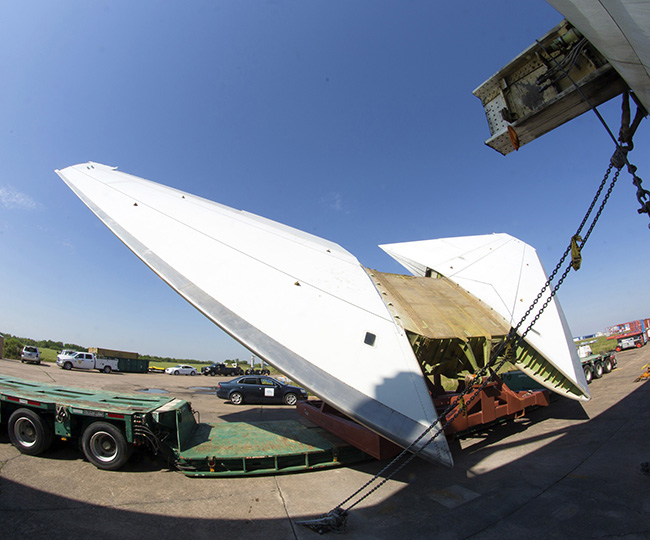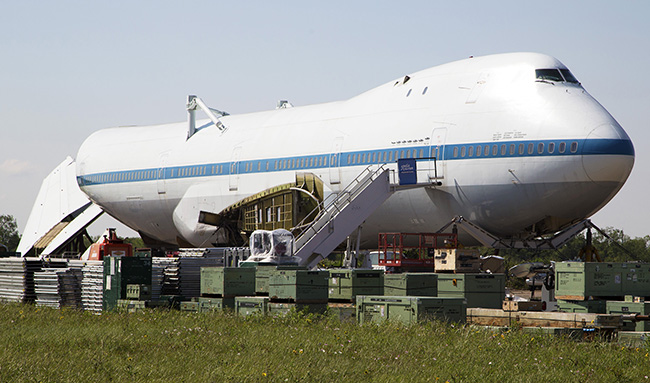A Last Piggy-Back Airplane
Today, a last piggy-back airplane. The University of Houston's College of Engineering presents this series about the machines that make our civilization run and about the people whose ingenuity created them.
The idea of one airplane carrying another airplane into the sky goes back at least as far as 1916. That's when the British launched a Bristol Scout from a big seaplane. The idea was to increase the range of the fast little plane.
Piggy-backing was tried many times thereafter. Most trials fizzled. But, to launch the first commercial transatlantic flight in 1938, a large seaplane carried a small one aloft, got it going, and released it to finish the flight from Ireland to Montreal.

Left: A Bristol Scout being carried aloft on a large seaplane in 1916. Right: A mail/passenger seaplane, that carried too much fuel for takeoff, is being launched by a larger seaplane.
Then, in the '70s, NASA needed a way to get their new Space Shuttles back to Florida from other landing fields. They chose the now-familiar, but highly-improbable, placement of a Shuttle on the back of a Boeing 747. NASA was skeptical at first. They bought into it only after engineer John Kiker built and flew radio-controlled models of the 747/Shuttle configuration. Kiker knew the long history of piggy-back airplanes. But, on this scale, he also knew the idea could not simply be explained. It had to be shown.
Boeing modified a commercial 747 for NASA in 1976. NASA added a second one in '91, but finally retired it to be cannibalized. It provided parts for a third 747, the one that carries NASA's Stratospheric Telescope.
But that first one served for 36 years - until it took the Shuttle Endeavor to rest in Los Angeles. I caught up with it on its way to its own final display in Space Center Houston, where it'll carry a Shuttle replica. (We were disappointed when Houston didn't get one of the three surviving Shuttles. But we will have the first and last Shuttle Carrier Aircraft[or SCA] as NASA calls it.)

SCA and Shuttle Endeavor on Endeavor's last flight to Los Angeles
I visited that venerable airplane on Good Friday of 2014. There it lay, dismantled for its move to the Space Center - strewn among wildflowers in a corner of Ellington Field. A fine controlled chaos: Wings over here, most of the body there, landing gear, flaps, more body parts along the road - a majestic tail-plane drawing our eyes away from the rest.

The SCA (Boeing 747) being dismantled prior to its move.
The dismantling went on with the same loving care we might lavish on a rescued sea bird. Pieces carefully laid out on the grass, or gently cradled on heavy hydraulic lifts. It was only temporary, but it gave an intimate look at how an airplane carried 350 or so tons of its own and the Shuttle's weight.

The wings in the foreground, body in the distance
Those naked bones raised more questions than they answered. How did anyone think all this up? Here's the main beam that anchors the wing. But its placement seems wrong. How am I to make sense of all the entrails - ducts, bulkheads, wiring, hydraulics? The complexity seems to outrun any one person's understanding.

The exposed interior of the fuselage once the wing has been removed
I wish NASA visitors could see what I'd seen. The reassembled 747-with-Shuttle surely makes a thing of beauty. But good engineering means shaping order from chaos. And that chaos of parts was a glimpse into the raw genesis of a radical idea that really worked.
I'm John Lienhard at the University of Houston, where we're interested in the way inventive minds work.
My thanks to Paul Spana and Jack Moore of NASA for their extraordinary kindness in showing me the amazing sight of the SCA (the Boeing 747) dismantled, and ready to make its eight-mile journey to Space Center Houston on April 28-30, 2014.
 Click on this icon to see the history of the SCA flights spelled out on the side of the airplane.
Click on this icon to see the history of the SCA flights spelled out on the side of the airplane.
For more on the modified Boeing 747s see Wikipedia pages on Shuttle Carrier Aircraft, and the SOFIA or Stratospheric Observatory for Infrared Astronomy. This Smithsonian page gives a brief history of Piggy-back airplanes. The lead example is the transatlantic flight that I mention in the text above. For more on John Kiker's radio-controlled model scroll 2/3 the way down this NASA page.
I wrote this in advance of the SCA move to JSC. Here is NASA's concept of the finished display. I should point out that the Shuttle replica in the Space Center Exhibit (unlike the three real Shuttles) allows visitors to enter it and see it from the inside.
All color photos by J. Lienhard. Black and white images are courtesy of the Smithsonian Institution and Wikimedia Commons. Additional images below:

The inside the body of the SCA was left empty to reduce its load. But we see a greatly beefed up bulkhead to help support the Shuttle.

The elevator (or horizontal stabilizer of the tail). It has a 47 foot "wingspan". The beam in the upper right is the main structural support for the wing.

Inside of the second to last portion of the fuselage which has been removed from the main body.

The stripped-down SCA fuselage, ready to be moved.
This episode was first aired on April 28, 2014